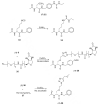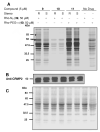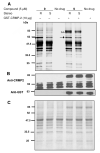Lacosamide isothiocyanate-based agents: novel agents to target and identify lacosamide receptors
- PMID: 19795888
- PMCID: PMC2783890
- DOI: 10.1021/jm9012054
Lacosamide isothiocyanate-based agents: novel agents to target and identify lacosamide receptors
Abstract
(R)-Lacosamide ((R)-2, (R)-N-benzyl 2-acetamido-3-methoxypropionamide) has recently gained regulatory approval for the treatment of partial-onset seizures in adults. Whole animal pharmacological studies have documented that (R)-2 function is unique. A robust strategy is advanced for the discovery of interacting proteins associated with function and toxicity of (R)-2 through the use of (R)-2 analogues, 3, which contain "affinity bait (AB)" and "chemical reporter (CR)" functional groups. In 3, covalent modification of the interacting proteins proceeds at the AB moiety, and detection or isolation of the selectively captured protein occurs through the bioorthogonal CR group upon reaction with an appropriate probe. We report the synthesis, pharmacological evaluation, and interrogation of the mouse soluble brain proteome using 3 where the AB group is an isothiocyanate moiety. One compound, (R)-N-(4-isothiocyanato)benzyl 2-acetamido-3-(prop-2-ynyloxy)propionamide ((R)-9), exhibited excellent seizure protection in mice, and like (R)-2, anticonvulsant activity principally resided in the (R)-stereoisomer. Several proteins were preferentially labeled by (R)-9 compared with (S)-9, including collapsin response mediator protein 2.
Figures





Similar articles
-
Synthesis and anticonvulsant activities of (R)-N-(4'-substituted)benzyl 2-acetamido-3-methoxypropionamides.J Med Chem. 2010 Feb 11;53(3):1288-305. doi: 10.1021/jm901563p. J Med Chem. 2010. PMID: 20041718 Free PMC article.
-
Proteomic searches comparing two (R)-lacosamide affinity baits: An electrophilic arylisothiocyanate and a photoactivated arylazide group.Org Biomol Chem. 2010 Jun 21;8(12):2803-13. doi: 10.1039/c000987c. Epub 2010 Apr 19. Org Biomol Chem. 2010. PMID: 20405068
-
Synthesis and anticonvulsant activities of N-benzyl (2R)-2-acetamido-3-oxysubstituted propionamide derivatives.Bioorg Med Chem. 2008 Oct 1;16(19):8968-75. doi: 10.1016/j.bmc.2008.08.055. Epub 2008 Aug 28. Bioorg Med Chem. 2008. PMID: 18789868 Free PMC article.
-
Lacosamide: a review of preclinical properties.CNS Drug Rev. 2007 Spring;13(1):21-42. doi: 10.1111/j.1527-3458.2007.00001.x. CNS Drug Rev. 2007. PMID: 17461888 Free PMC article. Review.
-
Specific binding of lacosamide to collapsin response mediator protein 2 (CRMP2) and direct impairment of its canonical function: implications for the therapeutic potential of lacosamide.Mol Neurobiol. 2015 Apr;51(2):599-609. doi: 10.1007/s12035-014-8775-9. Epub 2014 Jun 20. Mol Neurobiol. 2015. PMID: 24944082 Free PMC article. Review.
Cited by
-
GSK3-CRMP2 signaling mediates axonal regeneration induced by Pten knockout.Commun Biol. 2019 Aug 23;2:318. doi: 10.1038/s42003-019-0524-1. eCollection 2019. Commun Biol. 2019. PMID: 31453382 Free PMC article.
-
Drug binding assays do not reveal specific binding of lacosamide to collapsin response mediator protein 2 (CRMP-2).CNS Neurosci Ther. 2012 Jun;18(6):493-500. doi: 10.1111/j.1755-5949.2012.00313.x. CNS Neurosci Ther. 2012. PMID: 22672303 Free PMC article.
-
Design of Engineered Cyclodextrin Derivatives for Spontaneous Coating of Highly Porous Metal-Organic Framework Nanoparticles in Aqueous Media.Nanomaterials (Basel). 2019 Aug 1;9(8):1103. doi: 10.3390/nano9081103. Nanomaterials (Basel). 2019. PMID: 31374940 Free PMC article.
-
Development of Glucose Regulated Protein 94-Selective Inhibitors Based on the BnIm and Radamide Scaffold.J Med Chem. 2016 Apr 14;59(7):3471-88. doi: 10.1021/acs.jmedchem.6b00085. Epub 2016 Apr 4. J Med Chem. 2016. PMID: 27003516 Free PMC article.
-
Synthesis and anticonvulsant activities of (R)-N-(4'-substituted)benzyl 2-acetamido-3-methoxypropionamides.J Med Chem. 2010 Feb 11;53(3):1288-305. doi: 10.1021/jm901563p. J Med Chem. 2010. PMID: 20041718 Free PMC article.
References
-
- Hauser WA, Annegers JF, Kurland LT. The prevalence of epilepsy in Rochester, Minnesota, 1940-80. Epilepsia. 1991;32:429–445. - PubMed
-
- Evans JH. Post-traumatic epilepsy. Neurology. 1962;12:665–674. - PubMed
-
- Lindsay JM. Genetics and epilepsy. Epilepsia. 1971;12:47–54. - PubMed
-
- Rogawski MA, Porter RJ. Antiepileptic drugs: Pharmacological mechanisms and clinical efficacy with consideration of promising development stage compounds. Pharmacol. Reviews. 1997;42:223–286. - PubMed
- McNamara JO. Ch. 21. In: Hardman JG, Limbird LE, editors. Goodman & Gilman’s The Pharmacological Basis of Therapeutics. 10th Ed McGraw-Hill; New York: 2001. pp. 521–547.
- Aiken SP, Brown WM. Treatment of epilepsy: Existing therapies and future developments. Frontiers in Bioscience. 2000;5:124–152. - PubMed
-
- Brodie MJ, Dichter MA. Antiepileptic drugs. New England J. Med. 1996;334:168–175. - PubMed
Publication types
MeSH terms
Substances
Grants and funding
LinkOut - more resources
Full Text Sources
Other Literature Sources

